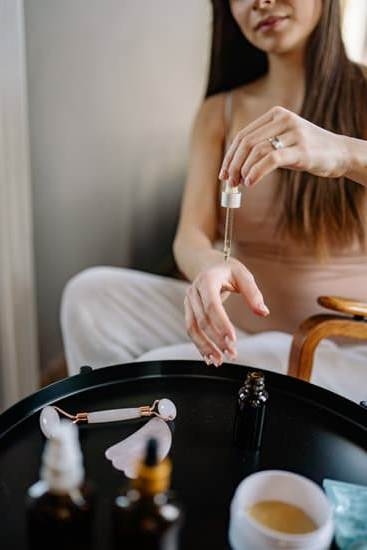Introduction
Loose skin after pregnancy can occur when your body’s connective tissues are stretched while pregnant, and that stretching causes diminishing of elasticity in the skin. The most affected areas are primarily the stomach, breasts and lower back. Loose skin can also be caused by hormonal changes due to childbirth. Postpartum hormones cause rapid fluctuations in body composition, which can lead to muscle loss, fluid retention and skin laxity.
To help prevent loose skin during or after pregnancy, you should try to maintain a healthy diet and lifestyle that helps support the health of your body’s connective tissue. Eating nutritious foods rich in omega-3 fatty acids like salmon helps promote collagen production and strengthen fascia-layer proteins of the skin. Exercise is also key as it raises your heart rate and increases circulation to nourish the skin with oxygen-rich blood. Finally, use a moisturizer that is rich in antioxidants such as vitamin C to nourish your dry or fragile skin.
Additional Tips:
1) Increase Collagen Production: There are several supplements available that claim they help boost collagen production such as hydrolyzed marine collagen, ceramides and elastin. These act as building blocks needed for creating strong, supple dermal layers of the skin.
2) Consider Laser Treatments: Laser treatments can address loose skin by gently heating up different depths of tissue promoting an increase of collagen formation leading to more toned underlying structure and improved look of sagging skin areas.
3) Eat Nutrient Rich Foods: Eating nutrient-rich green leafy vegetables like spinach, kale and Swiss chard provide essential vitamins A & E which naturally protect the cells from damage and inflammation resulting from aging or environmental assaults on delicate tissues surrounding fat cells that can lead to loose sagging stretched areas on the body especially post pregnancy when our bodies have seen extreme fluctuations in hormonal levels leading to rapid metabolic fluctuations amongst other conditions impacting our bodies overall functioning capacity and ability for regeneration processes we thought would last forever!!
Diet and Nutrition Changes
Regaining your pre-pregnancy body, or something close to it, after giving birth often means making some changes to the types of foods you are eating and the amount of calories you are consuming. Eating a healthy diet enriched with essential vitamins, minerals and antioxidants can help create collagen for firmer skin by aiding your body’s natural healing process. Increase your intake of vitamins A, E and C through foods such as oranges, spinach, wild salmon and nuts. Healthy sources of fatty acids should also be introduced into your diet like avocado, olive oil and almonds. Foods with plenty of protein will help boost production of collagen so include more lean meats such as chicken, beef and turkey as part of regular meals. The best way to ensure that you’re getting all the necessary nutrients is by maintaining variety in your diet; incorporating frozen fruits and vegetables into meals can create visually appealing dishes while still helping nourish the skin. Staying hydrated throughout the day can also help counteract any dryness which may have been caused due to reduced collagen levels during pregnancy so be sure to incorporate plenty of water into each day.
Exercise
Regular exercise is one of the most powerful ways to help loosen and tighten sagging skin after pregnancy. However, it’s important to create a workout routine that targets specific areas of skin that need toning. A few suggested exercises that can be done are squats, deadlifts, and planks for those targeting their core area. Lunges, bent-over rows, and bicep curls can also be included in a workout routine for sagging skin on your arms or legs. Additionally, women facing this issue should consider doing cardio exercises such as running or cycling–not only do they tone muscles, but they also help burn calories.
Additionally, there are some helpful tips to keep in mind while creating an effective post-pregnancy workout routine. Make sure to take rest days throughout the week so you’re not putting too much strain on your body all at once. Additionally, don’t forget about stretching and cooling down; both are important parts of any exercise routine. Finally, drink lots of water beforehand and after each session so you remain hydrated and energized throughout each session!
Professional Care Options
Many expecting mothers have concerns about how their body may change following childbirth, with loose skin being one of the main worries. Fortunately, there are a variety of professional treatments available that can help fix this issue. Depending on the degrees of sagging skin and individual goals, there are several options to choose from.
One popular procedure many women turn to is a tummy tuck. Also known as an abdominoplasty, this type of surgical procedure helps remove excess fat and tighten abdominal muscles which in turn reduces sagging of the stomach skin. It is designed to restore a more toned look to the mid-section. Along with reducing the appearance of loose skin around the abdomen, liposuction can be used in combination with a tummy tuck for added contour definition and improved results.
Some women may feel more comfortable with minimally invasive methods such as laser or light-based treatments that resurface or remove targeted areas or excess fat cells from problem areas like the stomach. These methods involve only tiny incisions and don’t require overnight hospital stays for recovery time compared to larger surgeries such as liposuction and tummy tucks.
Microdermabrasion is another type of treatment often used when helping after pregnancy loose skin cases. Unlike deeper resurfacing procedures like dermabrasion, microdermabrasion is a gentler form of exfoliation where tiny crystals slough away dead skin cells while stimulating collagen production at the same time. This helps smooth out wrinkles and create an even tone in your complexion while reducing any scarring caused by stretch marks during pregnancy, resulting in healthier overall looking skin all around the body
Skin Care Tips
Nutrition
Maintaining a nutritious diet with adequate hydration can help to reduce and prevent excess skin from forming. Nutrients such as elastin, collagen, and Vitamin C are especially important for skin elasticity. Eating foods like eggs, fish, beans, and leafy greens will provide your body with all the necessary nutrients to promote healthy skin. Additionally, staying adequately hydrated with water is incredibly important when it comes to maintaining your skin’s elasticity – replace sugary or caffeinated drinks with at least eight glasses of water per day.
Exercise
Engaging in moderate exercise on a regular basis will not only help to improve your overall fitness but can also help stimulate blood circulation and restore the tightness of your skin. Exercise helps build muscle strength which can then work under the surface to reshape flank lines and help roll back any unsightly belly fat that might be leftover from pregnancy. However, it is important to listen to both your body and your doctor before beginning any physical activity after childbirth as recovery times may vary depending on factors such as tears or c-sections during delivery.
Good Sleep Habits
Poor sleep habits can lead to an increase in cortisol levels which can cause further saggy skin and wrinkles. Establishing a bedtime routine is essential for good sleep health; try going through short rituals before you go to bed each night such as light stretching, reading a book, or writing down any thoughts so that you drift off faster into a restful slumber. Restorative sleep plays an important role in managing stress hormones which keeps skin youthful and vibrant!
Conclusion
Self-care is essential in helping to prevent and combat loose skin after pregnancy. Eating a healthy, balanced diet provides the nutrients necessary for skin regeneration and keeping one hydrated helps prevent skin from becoming dry and brittle. Exercise is also key in both preventing and combating loose skin, as it increases blood flow and collagen production and helps to tone up the areas where the skin may be most affected. Taking care of your skin with lotions, creams, gentle exfoliation, avoiding overwashing or scrubbing can also help keep your new postpartum body feeling smooth and rejuvenated. All these simple techniques build up over time to create lasting results that will help you look your best as you transition into motherhood. It’s important to remember that every woman is different when it comes to loose skin during or after pregnancy – what works for some may not necessarily work for others. With this in mind, each individual should focus on what works best for her particular body type, lifestyle and goals. Your self-care routine should always be tailored toward meeting your individual needs so that you will continue to feel beautiful long after returning home from the hospital with baby!

Welcome to my fertility blog. This is a space where I will be sharing my experiences as I navigate through the world of fertility treatments, as well as provide information and resources about fertility and pregnancy.





